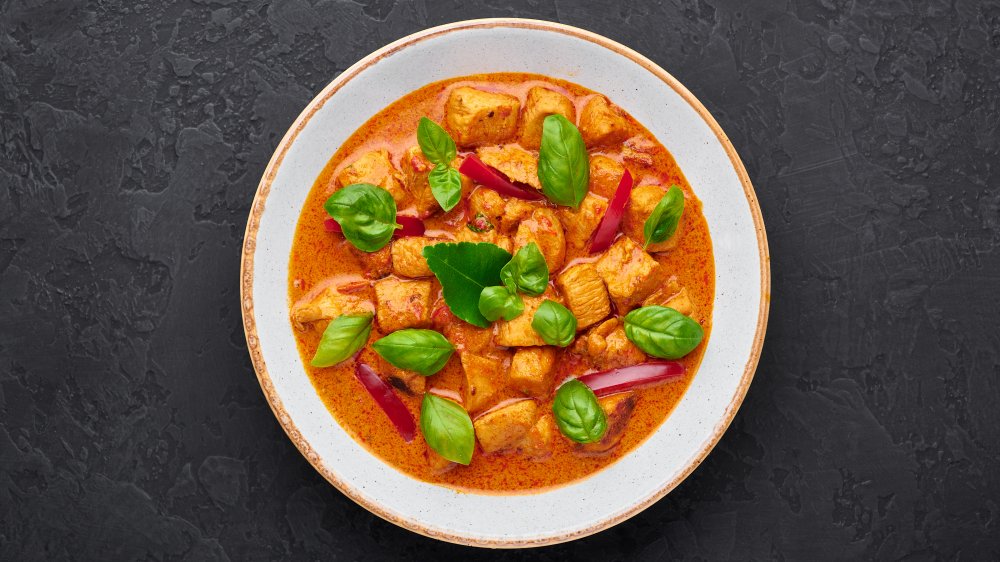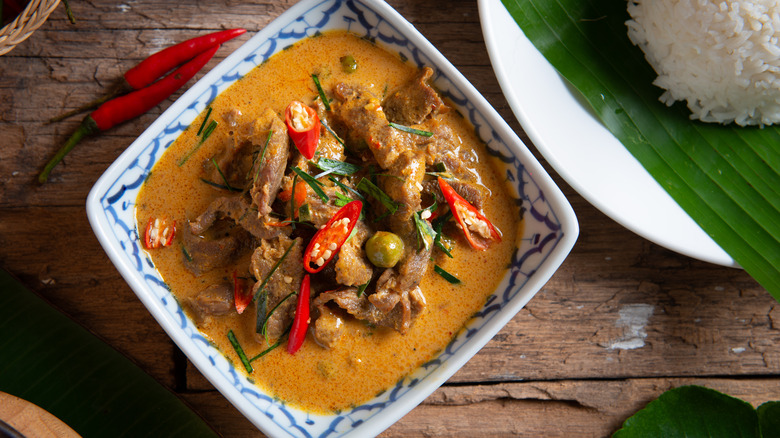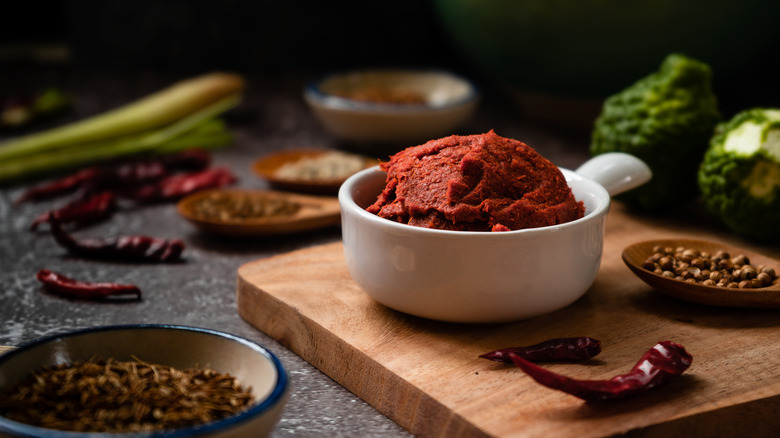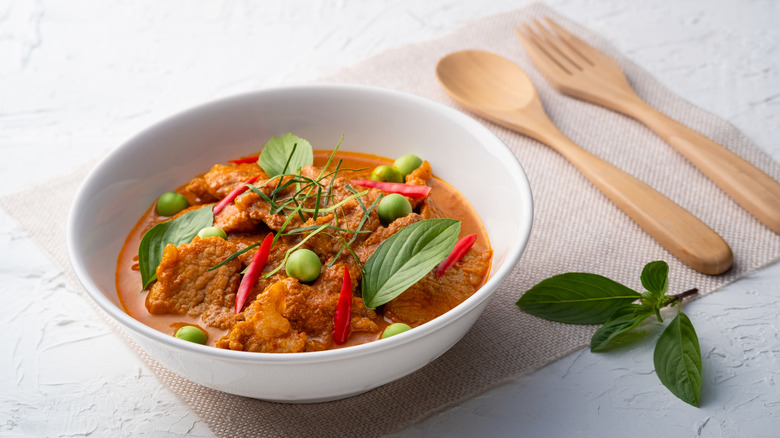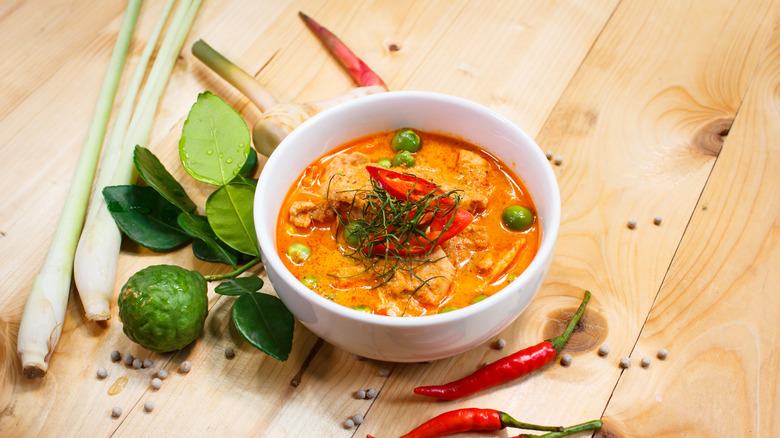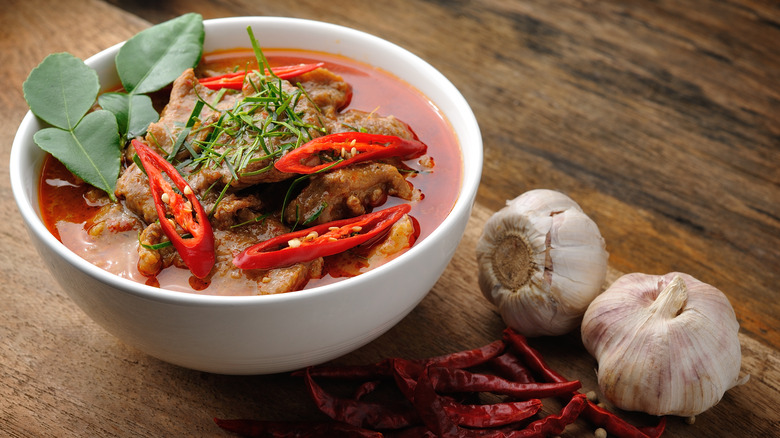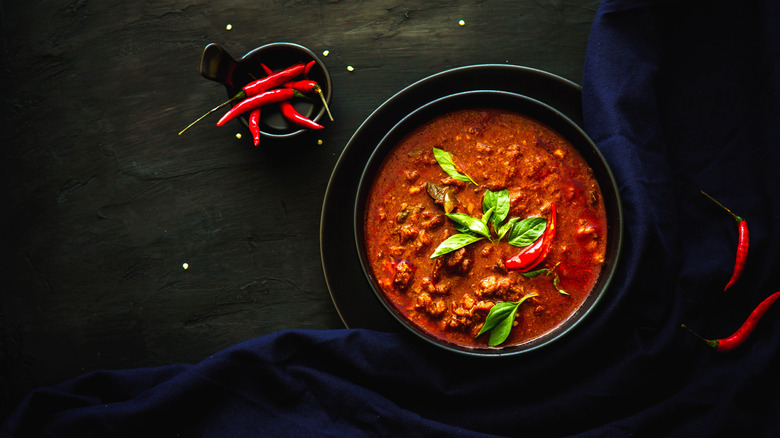What Is Panang Curry And What Is It Made Of?
Correction 10/4/22: An earlier version of this article stated that Panang curry originated in Penang, Malaysia. It is debated whether Panang curry originated in Malaysia or Thailand.
Along with yellow, red, green, and Massaman varieties, Panang curry is one of the five best-known Thai curries, according to Inquiring Chef, though there are hundreds of curry variations based on regions and family recipes. (Some of the other most popular varieties include red, green, yellow, and Massaman curries.) Panang curry (sometimes referred to as Penang curry, per The Spruce Eats) starts with a basic curry paste recipe, to which coconut milk or broth are added to make a curry sauce, Inquiring Chef explains.
While some believe this curry originated in Penang, an island located off the west coast of Malaysia (per On the Gas), others believe it originated in central Thailand, per Wander Cooks.
If you've never tried Panang curry, you can make it at home. But because like many curry dishes, the list of ingredients can be pretty long, and you might find it easier to satisfy your Panang curiosity at your neighborhood Thai restaurant. These pastes generally start with lemongrass, galangal (a relative of ginger), shrimp paste, coriander, and other aromatics. Other ingredients are then added to achieve the different curry variations, Inquiring Chef notes. Green curry, for instance, relies on the addition of fresh green chilis. For yellow curry, turmeric and dried curry powder impart its distinctive flavor and color.
What is Panang curry?
Panang curry shares many of the basic elements and flavors found in other curries, notes Inquiring Chef. Its chief difference lies in one key ingredient: the peanut. Panang curry is all about the peanuts, and it's the only one of the five main curries to incorporate them.
A recipe that yields 3/4 cup of Panang curry paste incorporates about three tablespoons of peanuts, per Epicurious. This ingredient imparts Panang curry with a nutty, mellow flavor and texture that makes it distinct from other curries.
Because red curry looks a lot like Panang curry, it can be easy to confuse the two. In fact, because they share similar ingredients, some people consider Panang simply a variation on red curry, according to On the Gas. But in addition to the peanuts, Panang differs from red curry in that it contains less red chili pepper, so it isn't quite as spicy. Also, although some red curry recipes contain coconut cream or coconut milk, this ingredient is present in nearly all Panang curries, making it sweeter and creamier than red curry, On the Gas notes.
How is Panang curry made?
If you can find it, Panang curry paste is the ideal base for making a Panang curry. But if you can't find Panang curry paste, a simple red curry paste will do, too.
You can even make homemade Panang curry paste, if you're feeling inspired. Per Epicurious, a Panang curry paste will include dry ingredients such as chiles, lemongrass stalks, cumin, lime leaves, and, of course, peanuts. If you're short on time, some specialty stores sell jarred Panang sauce, and Trader Joe's offers a microwavable Panang Vegetables with Jasmine Rice (per Kitchn).
American interest in Thai cuisine makes it easy to find recipes for Panang curry. Epicurious' Panang curry paste recipe contains 12 ingredients but will reward you with deliciously complex flavor. If you're using a pre-made curry paste, this recipe from Erren's Kitchen will yield a sweet, nutty weeknight Panang dinner in a flash.
Where to buy Panang curry paste
Local Asian markets will likely carry Panang curry paste, or at least red curry paste. You'll also likely see powdered curry paste or jarred curry sauces at grocery store chains, especially in the "international" aisle. Kroger, for instance, carries the Mae Ploy Panang Curry Paste powder, and Target's Good & Gather line has a jarred Panang curry sauce. Walmart also carries the canned Maesri Thai Panang Curry Paste; you may not have to head to a specialty store to find this ingredient. However, if you're making a Panang curry paste from scratch, ingredients like lime leaves may be tricky to find at a supermarket chain; for those, a specialty store will come in handy.
Online retailers also offer a variety of Panang curry paste and curry sauce options. Thrive Market carries Yai's Thai Panang curry sauce, and you can find Mae Ploy Panang Curry Paste at Amazon, too.
If you're relying on a jarred Panang curry sauce, check the ingredient list for things like lemongrass, lime leaves, peanut butter, and red chili peppers — the ingredients you'd find in a Panang curry recipe.
How is Panang curry served?
As Mashed's Panang curry recipe explains, this sauce is often served with jasmine rice or sticky rice, along with vegetables and a protein such as chicken. Lime wedges and some additional hot sauce round out the meal. Mashed's recipe features onion, multiple colors of bell peppers, garlic cloves, and ginger, but you can doctor your curry recipe to suit your individual taste. A little fresh basil will elevate your Panang curry, too.
Don't feel limited to chicken and vegetables, though. This Panang curry recipe from Hungry Huy, for instance, pairs the red sauce with beef short ribs for an unexpected flavor combination. Sugar Salt Magic also has a recipe for Panang curry with shrimp — there are plenty of possibilities out there. You can even find vegan panang curry recipes that eliminate the fish sauce, such as this one from Curry and Vanilla.
When you're plating Panang curry, Hot Thai Kitchen suggests serving the dish in a "deep plate or a shallow bowl" and topping the curry off with chili slices, lime leaves, and an additional splash of coconut milk.
Does Panang curry taste different from red curry?
As previously mentioned, Panang curry is similar to red curry, though there are distinctions between the two. Panang curry is sweeter than red curry, as it's made with coconut milk or coconut cream, per On the Gas. Red curry, on the other hand, is spicier than Panang curry. Per Thrive Cuisine, Panang curry tends to be sweeter and milder than other types of curry.
Panang curry, of course, also features peanuts or peanut butter, which aren't always present in red curry recipes. If you love the taste of peanuts and prefer a sweeter, less spicy type of curry sauce to serve with your rice and vegetables, Panang curry is a great option.
Texture-wise, Panang curry is a bit different from red, green, and yellow curries, too. As Thrive Cuisine explains, Panang curry can be "thicker and less soupy" than other curry varieties.
What if you don't have red curry paste?
If you want to whip up a bowl of Panang curry at home but don't have red curry paste, don't fret. There are a number of substitutes for red curry paste that will work in a pinch.
Yellow and green curry paste are acceptable substitutes for red curry paste. Green and red curry pastes have similar flavor profiles in terms of spice levels, while yellow curry paste is a bit milder. Both green and yellow curry pastes can be substituted for red curry paste in a 1:1 ratio.
Other red curry paste substitutes include a red pepper flake/tomato paste mixture, a turmeric-chili paste mixture, curry powder, a garlic-chili sauce mixture, and chili powder, per Substitute Cooking. The flavor won't be exactly the same, but you'll be able to enjoy a nice bowl of hot curry if you can't get to the store.
